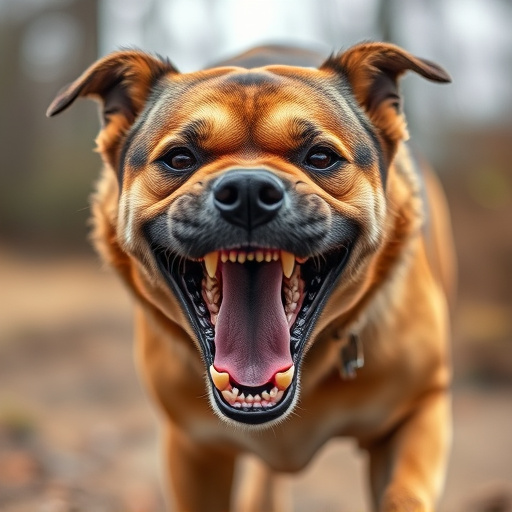Mace spray can neutralize dog attacks by irritating eyes and respiratory areas, but proper usage techniques and local regulations are crucial. Hold can 15-20 cm away, aim for face, activate briefly until threat neutralized. Observe reaction from safe distance; rinse affected area with water if adverse effects occur. Legal status varies; consult local laws. Use pet-safe alternatives to prevent irritation and poisoning. Focus on positive reinforcement training methods as primary prevention.
In the event of a dog attack, knowing how to effectively respond can be life-saving. One tool that has gained attention for self-defense is mace spray, specifically formulated to neutralize aggressive dogs. This article delves into understanding mace spray as a defense mechanism against dog attacks, exploring safe application techniques tailored for pet skin. We also discuss legal considerations surrounding ownership and provide alternative training methods and prevention tips to ensure your safety and that of your furry companions.
- Understanding Mace Spray for Dog Aggression
- Safe Application Techniques on Pet Skin
- Legal Considerations: Use and Ownership
- Alternative Training Methods and Prevention
Understanding Mace Spray for Dog Aggression
Mace spray, when used appropriately, can be a powerful tool for neutralizing dog attacks. It’s designed to temporarily disable an aggressor by irritating the eyes and respiratory system. In cases of dog aggression, mace spray works by creating a barrier between you and the attacking animal, providing crucial time to escape or seek help.
When considering mace spray as a defense mechanism, understanding its application is key. It’s important to learn how to properly deploy the spray while maintaining a safe distance from both the dog and any bystanders. Additionally, users must be aware of local regulations regarding the carrying and use of pepper spray, including restrictions on who can possess and where it can be used. Always prioritize safety and ensure that mace spray is a last resort when dealing with aggressive dogs. Remember, the goal is to neutralize the threat without causing lasting harm to the animal or anyone involved.
Safe Application Techniques on Pet Skin
When using mace for dog attack defense, it’s crucial to employ safe application techniques to ensure effectiveness without causing harm to pets or their owners. Start by ensuring proper ventilation; open windows and doors to minimize inhalation issues. Hold the can upright, 15-20 cm away from the target area, aiming for eyes, nose, and mouth. Activate the spray briefly, until the animal is neutralized, avoiding prolonged exposure to prevent excessive irritation.
After application, quickly move to a safe distance and observe the pet’s reaction. If the mace causes any adverse effects, like excessive panting or coughing, rinse the affected area with water for at least 15 minutes. Remember, the goal is to neutralize the threat without leaving lasting damage. Always store mace sprays out of reach of children and pets, and consider using pet-safe alternatives designed specifically for dog attack deterrence.
Legal Considerations: Use and Ownership
The use of mace for dog attack defense raises several legal considerations regarding its ownership and application. In many jurisdictions, mace spray is classified as a weapon, which comes with strict regulations. Owning and carrying mace may require permits or licenses, especially in urban areas where dog attacks are more prevalent. Users must understand the local laws to avoid legal repercussions.
When it comes to neutralizing mace spray on pet skin, it’s crucial to select non-toxic, pet-safe options specifically designed for animal use. Regular mace sprays can cause severe irritation and even poisoning in dogs and cats. Always consult with a veterinarian or animal control experts for recommended products that will effectively deter attackers without harming pets or their owners.
Alternative Training Methods and Prevention
While mace can be a powerful tool for neutralizing dog attacks, it’s important to note that prevention through alternative training methods is key. Positive reinforcement techniques, such as clicker training and reward-based learning, can effectively teach dogs good behavior and reduce aggression. Regular socialization and exposure to different environments, people, and animals help puppies grow into well-adjusted adults, minimizing the likelihood of fear-driven or protective attacks.
Additionally, establishing clear boundaries and a consistent routine can help manage potential triggers for aggressive behavior. Ensuring your pet gets adequate exercise, mental stimulation, and affection can also reduce stress and anxiety levels, making them less prone to reactive or defensive actions. Remember that addressing the root cause of a dog’s aggression is crucial, and consulting with a professional trainer or behaviorist can provide tailored guidance on effective training methods for your specific situation, focusing on neutralizing mace spray on pet skin as a last resort.
When faced with potential dog attacks, understanding and properly utilizing mace spray can be a life-saving tool. By grasping the safe application techniques for neutralizing mace on pet skin and being aware of legal considerations regarding ownership, responsible pet owners can better protect themselves and their loved ones. Additionally, exploring alternative training methods and prevention strategies can further reduce the likelihood of such incidents, fostering a safer environment for both pets and people alike.
